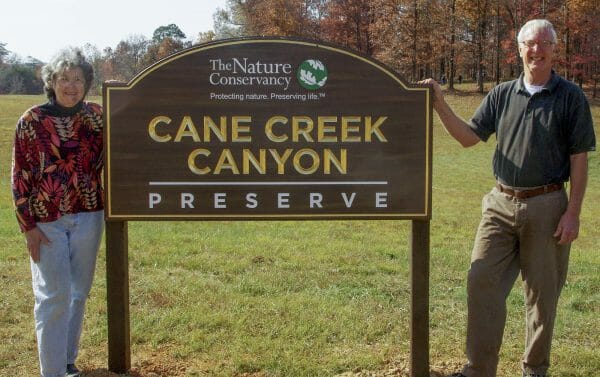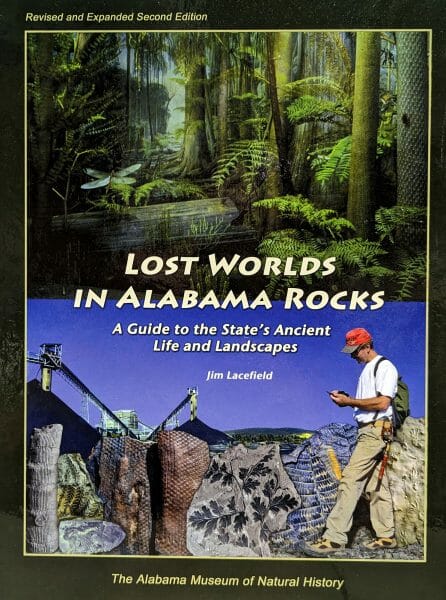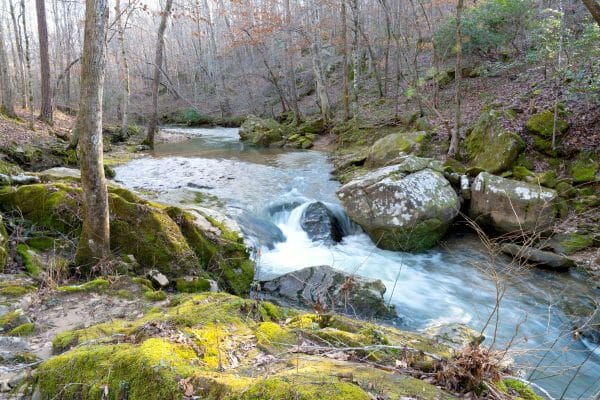James A. Lacefield
Jim Lacefield (1947- ) is an Alabama author, naturalist, and science educator, best known for writing the popular science book Lost Worlds in Alabama Rocks: A Guide to the State’s Ancient Life and Landscapes. The work, reprinted numerous times, has introduced thousands of students to the state's fossils, rocks, and geologic history. It has been used in geology, Earth science, biology, and paleontology classes from middle school through college, including as a text or supplemental text by a number of universities in the Southeast. Lacefield and his wife Faye also developed the Cane Creek Canyon Nature Preserve near Tuscumbia, Colbert County, and later donated it to the Land Trust of North Alabama for preservation and public use.
Lacefield was born on November 17, 1947, in Birmingham, Jefferson County, to William and Emma Jeanne Lacefield; he had two brothers. Lacefield grew up exploring the woods and creeks of Homewood, a Birmingham suburb. Particularly interested in the diversity of wildlife of the area, he set a personal goal of catching and examining every species of fish in the nearby ponds and streams of the Shades Creek watershed.
Encouragement from early instructors set Lacefield on the path to his life's work: the study and teaching of Earth's natural treasures in Alabama. First, a sixth-grade teacher noticed his interest in the natural world and charged him with stocking and maintaining the class aquarium with bluegills, golden shiners, and other native fish. And in 1965, counselors at Shades Valley High School guided Lacefield into Alabama's first advanced placement biology class. In 1970, Lacefield married Faye Barrett of Elrod, Tuscaloosa County, who also would become an educator and play an important role in developing their future property into a nature preserve. The couple would have two children.
Lacefield received a bachelor of science degree in secondary education with a major in biology from the University of Alabama in 1971. A conscientious objector during the Vietnam War, he served alternative civilian service (1971-73) at the Magnolia School, a residential school for children with learning and behavioral difficulties in New Orleans, Louisiana. In 1974, while studying for a master of education degree at Livingston University (present-day University of West Alabama), his interests broadened to include paleontology, the study of fossils. The Lacefields often roamed the nearby backwoods and chalk ravines of the Alabama Black Belt. His discovery of well-preserved marine fossils opened the budding educator's eyes to the importance of using local fossils and sedimentary rocks in the teaching of natural history.
In 1979, Lacefield received a specialist degree in secondary education from the University of North Alabama (UNA) in Florence, Colbert County. Over the next two decades, he taught science and gifted education to students in public junior high and high schools in rural Tennessee and north Alabama and was briefly an instructor at Northwest-Shoals Community College in Muscle Shoals, Colbert County, from 1994-95. In 1995, he joined the faculty at UNA and taught biology and Earth science.
In 1998, Lacefield earned a doctor of education degree from the University of Alabama; during his time as a student there, he had been named Most Outstanding Student in Science Education in 1992 and received the Adolph Crew Teaching Award in 1995. His doctoral dissertation formed the early basis for what would become Lost Worlds in Alabama Rocks. Natural history textbooks specific to Alabama for post-elementary students were nonexistent until Lost Worlds in Alabama Rocks filled the gap when it was first published in 2000. The book, since reprinted, illustrates basic concepts of geology with examples that students can see in fossils and in the stratified cliffs along local rivers and canyons.
After his retirement from teaching in 2004, Lacefield served as consultant and instructor at teacher training workshops supported by Legacy, a nonprofit Alabama environmental education organization founded in 1992 and based in Montgomery.
Lacefield has lectured and published widely on the subject of human evolution and Alabama's biodiversity, fossils, and flora. Two fossil species are named in his honor: Zaphrentites lacefieldi, a Mississippian period horn coral; and Pharciphyzelus lacefieldi, a large Pennsylvanian insect.
In 2018, Lacefield received the Jeffrey Scott Hughes Lifetime Achievement Award from the Environmental Education Association of Alabama, named for the late founder of the Montgomery-based organization.
Cane Creek Canyon Nature Preserve
In 1979, the Lacefields settled near Tuscumbia, Colbert County. There, they bought 40 acres of undeveloped rural land that included sandstone canyons with scenic overlooks, boulder cascades, wildflower glades, and waterfalls located in the upper portion of the Cane Creek watershed of the Tennessee River. The Lacefields gradually increased their property to more than 700 acres, concentrating on acquiring land unsuited to agriculture that showcased the geology and the natural diversity of the native plants and animals of north Alabama. They created and maintained hiking trails at their own expense and largely with their own labor. One hiking trail has approximately 350 feet of elevation change from ridge top to creek level.
The Lacefields opened the property to the public in 1996 at no charge, naming it Cane Creek Canyon Nature Preserve. The site serves as an outdoor classroom for nearby schools and in many years attracts more than 10,000 visitors. Multiple rare or previously unidentified species of plants and insects can be found in its wildflower meadows and many microhabitats.
For developing Cane Creek Canyon Nature Preserve, Auburn University presented Lacefield with the 2000 W. Kelly Mosley Environmental Award for Achievements in Forestry, Wildlife, and Related Resources. In 2007, the Lacefields placed the preserve in a conservation easement with the Alabama Nature Conservancy to limit unwanted future development. In 2023, they donated the property to the Land Trust of North Alabama to ensure the land is properly and permanently cared for while also allowing continued low-impact public access.
Further Reading
- Black, Hank. “Cane Creek Canyon Nature Preserve a Hidden Gem in Northwest Alabama.” Alabama News Center, May 23, 2016; https://alabamanewscenter.com/2016/05/23/cane-creek-canyon-nature-preserve-hidden-gem-northwest-alabama/
- Deutsch, William George. Ancient Life in Alabama: The Fossils, the Finders, and Why It Matters. Florence, Ala.: MindBridge Press, 2022.
- Lacefield, Jim. Lost Worlds in Alabama Rocks: A Guide to the State’s Ancient Life and Landscapes. 2000. Reprint, Tuscaloosa: Alabama Museum of Natural History, 2013.
- –––. “Home Area Geology and Alabama Earth Science Teachers: A Resource to Improve the Understanding and Use of the State’s Rocks to Supplement Textbook Concepts in Earth History.” Ed.D. thesis, University of Alabama, 1998.












